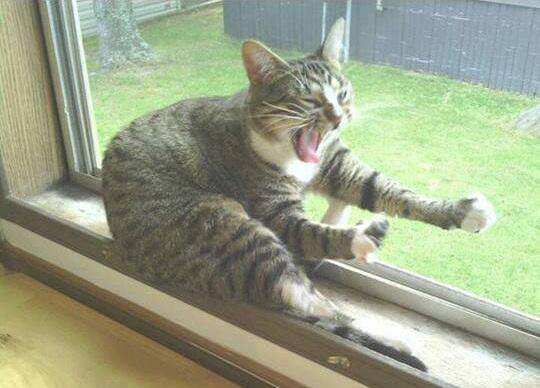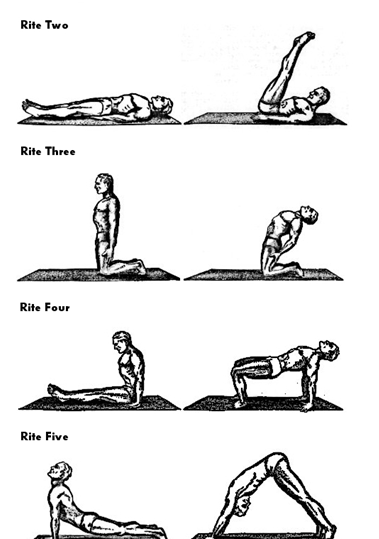Guidance - Healthy Lifestyle Report
Welcome welcome welcome to another installment of the Healthy Lifestyle Report!
I just spent a few days at the North Texas Food Bank giving massages to the workers there. Had a great time. Everyone was very friendly and genuinely concerned for their health, which I love to see, so naturally a bunch of those wonderful people are on here now.
The main thing I noticed while I was there, when I asked them about their lifestyle habits, was the lack of self-care routines for stretching and exercising.
Just like a car, you must do regular maintenance to keep things running smoothly. So let’s see what maintenance the body needs:
I am going to give a brief introduction and then get into some actionable steps, then wrap it up with something interesting.
Balance -
A Healthy Lifestyle is well-balanced. In order to do that, awareness is key.
There are 3 main forms of exercise that need to be done in order to keep your body in tip top shape.
I want to introduce you to the Triangle of Triumphant Exercise – (yes, I just made that name up)
Aerobics

Weight-bearing Stretching
Aerobics AKA Cardio – Arguably the most important, but probably the most neglected, exercise of all, since heart disease and cancer are the 2 biggest killers in America, and this form of exercise does much of what is needed to prevent them. Cancer thrives in low-oxygen, unexercised tissue. Heart disease occurs more readily within a weak heart. Cardio gets the body warmed up, the heart pumping, the blood and lymph circulating, maintains fit heart and lungs, burns fat and calories, and makes you feel GOOD! As long as you moderate yourself.
“Consistency, rather than extreme intensity, produces the benefits of exercise. Challenge yourself, but be realistic” – Raymond Francis M.Sc. Never Be Sick Again
Weight Bearing – Always warm up body and stretch beforehand. – increases muscle strength and endurance, promotes healthy bones, joints and connective tissues, and subsequently prevents diseases like arthritis and osteoporosis. We’ll get more into this another time…
Anaerobic is one more form of exercise I’ll mention briefly just so you are aware – This is the type where you start and stop in intervals, such as tennis or rock climbing. This is useful exercise if you plan on doing that type of sport or activity. Since, if you aren’t conditioned for it, performance will slack, and risk of injury is increased.
Since Aerobics is simple enough for now, just go for a brisk walk! I’m going to start you off with a healthy dose of stretching AND the psychology behind motivation.
As a brilliant man once put it, “Common Sense is not always common practice"
How to adopt the Habit of Stretching -

In this report, I want to give you some valuable information and walk-thrus on stretching
One of the first things I ask someone who has tight muscles is "are you stretching regularly" and I'm shocked at how many people say "not enough" or even "not at all"! And they pretty much always have a somewhat defeated look on their face like they know better.
Stretching is so simple and easy to do. As long as you’re not in the middle of a heart bypass surgery or scrambling for your life away from a tiger, there’s really no good excuse why you aren’t doing it. And right after that surgery or survival run is the perfect time for stretching too.
So, it's quite obvious to me that people just don't understand how important it is and just how easy it is.
You brush your teeth daily because you don't want cavities or gum disease, right? Well, what do you do on a daily basis to prevent tension in your neck? Brushing your teeth offers you preventive dental care, but what are you doing to be preventive with the rest of your body?
This rests essentially on the mechanism of habits. Habits are mental programs that happen without conscious thought. You don’t need to think about brushing your teeth. Your mind probably wanders while you do it. You just need to decide to do it. And even that decision is often a program. Studies from as far back as the seventies show that our brains begin to prepare for action just over a third of a second before we consciously decide to act.
Neuroscientists have shown that the conscious mind provides 5% or less of our cognitive (conscious) activity during the day – and 5% they say is for the more aware people, many people operate at just 1% consciousness.
It’s well known in the scientific community that the subconscious runs most of the show throughout the day. There is a conscious mind that can think freely and create new ideas ‘out of the box’. Then there is the subconscious mind, which is basically a super computer loaded with a database of programmed behaviors, most of which we acquired before we reached the age of six.
Dr. Bruce Lipton, a cell biologist from Stanford University and Author of “The Biology of Belief” states that the conscious mind only processes 40 bits of information per second, whereas the subconscious mind process 40 MILLION bits per second. In other words, it is like a super computer that runs whatever program it is given *without question*. I want to make sure you heard that, WITHOUT QUESTION. Whatever habit you give it, whether you were thinking about it or not, it will continue to run that program until it receives different instructions.
Problem arises when people don’t know how to communicate with the subconscious.
It’s simple. That which is repeated enough times, the brain recognizes as important and will begin to weave neural pathways in the brain to make that action, thought, emotion, etc. easier to perform in the future.
Additionally, depending on the amount of emotion that is involved with the thought or action, the pathways in the brain will grow accordingly stronger.
In other words, something that you associate great amounts of pleasure, positivity, or gain to, you will form a habit of doing it way quicker than something that you simply know intellectually needs to be done… things you should do.
Inversely, something that you associate great negativity, loss,or pain to, you will form a habit of avoiding that task or topic much more rapidly.
This is how you grow a habit. But what do you do if your habit is already formed?
The awareness of neuroplasticity AKA “use it or lose it” and the willpower to create a new habit is enough in most cases.
Think of habit creation like getting in a rocket ship and leaving the planet. The rocket ship is your neural network and the fuel to get your ship to a new planet of operation is your willpower. You will have to use more than 90% of your fuel in the first few miles. The earth’s atmosphere is about 300 miles, but the majority is in the first 10 miles. This is where it takes the most fuel. After this initial breakthrough, it still takes consistent energy to leave the planet altogether, because there is still atmosphere and gravity impeding your desire. But it gets thinner and weaker the longer you keep at it. Once you have consistently kept your rocket ship’s nose pointed up and your fuel-power fired up for long enough, “use it or lose it” occurs. You lose the old program. The gravity of it no longer pulls at you. And you are free to decide where you want to go.
Now, if you don’t have a clear destination in sight, that old planet/pattern might start sounding ideal. Heck, atleast there was SOMETHING down there!
So just make sure you know where you are going and why you are going there before you leave.
Know thyself, or be victim of thine unknown self – unconscious self – subconscious mind.
Here are some new habits to set your sights on:
Take consistent breaks – You may not realize it presently, but something as simple as holding your arm up while driving a car is quite tiring. Especially if you have it straightened and are gripping excessively. Notice if you do a certain action for longer than 5 minutes without a break. This prolonged muscle contraction will turn into a knot if it isn’t allowed proper time to rest and relax. You can either switch arms or switch positions to give certain muscles a break.
It only takes 10 seconds to lengthen the tight tissue, which will take pressure off your joints and prevent chronic conditions like tendinitis and bursitis. Watch for opportunities to work in a brief stretch. You can do this while in your car driving, switching hands and stretching out the unused one. You can do it while in line at the bank or grocery store, or anywhere really. You can do it at work after you finish a consultation or meeting or number crunch or what have you. There are “periods” in your day where you can insert a 10-30 second stretch break with a nice full deep breath. Look for them. Don't tell yourself that they aren't there.
This is a very simple task, and that’s what makes it so insidious. It doesn’t seem important, but it is. You will be pulled back into your habit of not doing it, but you know what you are doing now!
Stretching Routine -
2-5 minutes when you wake up
5-10 minutes before you go to bed
This is a time to breathe deep, give thanks, and stretch thoroughly. You will function better, sleep better, and feel better. This time is well worth it. Remember, if you don’t brush your teeth until you have a cavity, you’ve waited too long. If you don’t drink water until you are thirsty, you are causing damage. If you don’t stretch until you are in pain and all knotted up, you are setting yourself up for hypertension, malfunction, misalignment, unnecessary pain, headaches, fatigue, weakened muscles, and a host of other complications. All this is relieved with a healthy habit of stretching.
Unwind – If you push all day, you need to pull those muscles into a stretch. If you flex all day, you need to extend them into a stretch. If you twist one way…you… that’s right… twist the other way to stretch. Pay attention to how you use your muscles consistently and do the opposite action, even exaggerated, to experience the stretch of the muscles that you chronically use.
Here are some examples – These are the last 4 of the 5 Tibetan Rites, since the first one is based on the chakra system, and I aim to keep things purely, rationally scientific in these reports.

Rite #2 Strengthens the core and stretches the hamstrings. Both the hamstrings and the psoas will be shortened all day long with people who sit for work or anything else consistently. It’s important to balance that out. Here’s a good video on the psoas stretch. If it doesn’t work just search for “psoas stretch” - http://www.youtube.com/watch?v=yfswfLuW_tI
Rite #3 Strengthens the mid-back and stretches the anterior neck and chest muscles. This is great for anyone who has the hands forward all day typing or working. You are pulling the elbows towards each other while pulling your head back.
Rite #4 Stretches the anterior deltoids and the mid back in between the shoulder blades. Also great for those who work with their hands forward all day. Since the shoulders are in flexion while you work, it’s important to stretch them into extension afterwards. I’ve seen that this one can be tough for some, but just do what you can and work towards the ideal at your own pace. You will get there with consistent practice.
Rite #5 Stretches full body front and back if you do it right. This is your basic upward and downward dog. Ideally, you should feel a stretch in your chest along with your hind legs. Start from a plank position with hands right beneath the shoulders and then go into it and keep going until your feel it in the chest.
Rite #6 I’m adding this on here because it is SO very useful. Use a pull up bar, a monkey bar, a tree limb, a sturdy shower curtain, anything that can hold your whole weight. Hang out. You’ll grab on with palms forward, slowly let the weight off your legs until you feel a real good stretch. Some people aren’t ready for the full weight of their body on their arms. That’s all good, work with what you got. Then hang there for 15-30 seconds. This aligns and lengthens the spine, allows for more communication and blood flow to compressed vertebral discs from sitting so much, and can even alleviate symptoms of sciatica and low back pain.
Types of Stretching
Ballistic – Quick, dynamic movements that increase pliability, blood flow, and detoxification through the lymphatic system. Also lengthens the muscle tissue, although static is more effective at this.
Static – Slow, prolonged positions that lengthen tissue. It also increases pliability. It’s not as effective at detox, and actually decreases blood flow during the stretch, but afterwards, due to softening of the tissues, it increase blood flow.
Contract – Relax – Stretch – This is a technique used by massage therapists and many other professionals. It is a modality that goes like this: Put the muscle into the desired stretch, hold, breathe, then contract that muscle while something or someone resists the action, then release that contraction and stretch the muscle just a little bit further.
You can increase flexibility and release some stubborn knots with this technique, as it supplies more blood flow to the tissues during the stretch and it incorporates the understanding of “Post Isometric Relaxation” which means that when you release the muscle contraction there is a brief moment where you can take the stretch a little further without your muscle trying to protect itself by tensing up.
A daily stretching routine will help prevent future issues and address current ones. Don't wait until it's a problem. Start stretching today and, little by little, your body will thank you.
Take this stuff and run with it! You'll be glad you did.
And now for the long awaited interesting fact: Did you know that it takes 43 muscles to frown and only 17 to smile? The next time you are feeling tired and stressed or depressed, just smile and experience the biochemical reaction to your attitude and the load off of your tired muscles! Since this is the second time I’m writing this, I want to frown and be all upset, but I realize it would serve no beneficial purpose, so I just smile and release the thoughts that create unhealthy stress… This is one of the few places in this day and age where it's actually EASIER to be happy. Go with tha flow yo

.
Alekzandr Apokalypto,
Omni Massage & Guidance
omg.massagetherapy.com
817-845-3515
